Archived Blog Posts
How To Find Your Home's Main Water Shutoff Valve
3/12/2023 (Permalink)
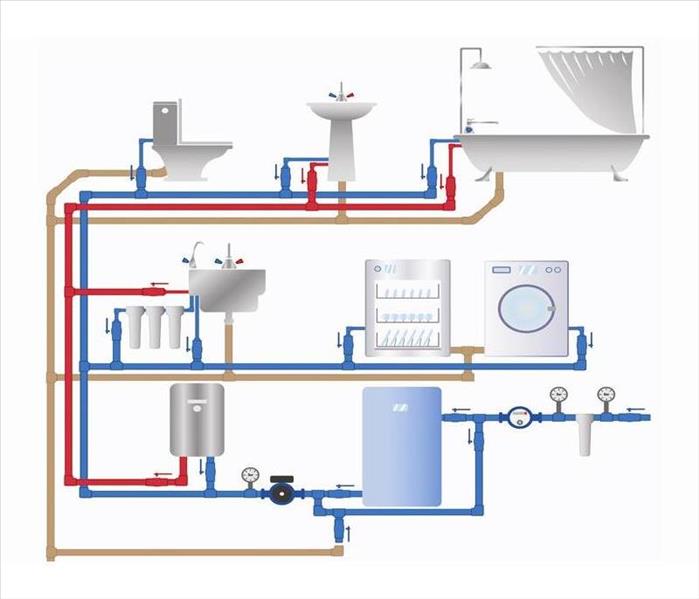 Finding your home's main water shutoff valve is an important step in protecting your property from water damage.
Finding your home's main water shutoff valve is an important step in protecting your property from water damage.
As a homeowner, it's important to know where your home's main water shutoff valve is located. In the event of a water emergency, such as a burst pipe or major leak, shutting off the main water supply can help prevent costly damage to your property. Here's how to find your home's main water shutoff valve.
Locate Your Water Meter
The first step in finding your main water shutoff valve is to locate your water meter. This is typically located outside your home, near the street or sidewalk. It may be inside a meter box or a covered pit.
Check the Area Near Your Water Meter
Once you've located your water meter, check the surrounding area for any visible pipes. Your main water shutoff valve is typically located within a few feet of your water meter, either inside or outside your home. Look for a valve or lever that controls the water flow.
Look for Your Home's Curb Valve
If you can't find your main water shutoff valve near your water meter, it's possible that your home has a curb valve. This valve is typically located near the street, in a box or pit. To access the curb valve, you may need a special tool or key. Contact your local water department to find out more information.
Check Your Home's Inspection Report
If you're still having trouble finding your main water shutoff valve, check your home's inspection report. This report should contain information about the location of your main water shutoff valve. If you can't find your inspection report, contact your home inspector or a local plumber for assistance.
Turn Off Individual Water Valves
If you cannot find your main water shutoff valve, the first thing you should do is turn off individual water valves. These valves are usually located near plumbing fixtures such as sinks, toilets, and water heaters. By turning off these valves, you can isolate the area where the problem is occurring and prevent further damage.
Label Your Valve
Once you've located your main water shutoff valve, it's important to label it so that it's easy to find in an emergency. Use a waterproof marker or label maker to mark the valve with "main water shutoff valve" or "emergency water shutoff." Make sure that all members of your household know where the valve is located and how to shut it off.
In conclusion, finding your home's main water shutoff valve is an important step in protecting your property from water damage. Take the time to locate your valve and label it for easy identification in an emergency. If you're having trouble finding your valve, don't hesitate to give our SERVPRO of Indiana County team a call today! Our team can help shut off the flow of water and clean up the mess that was left behind.
What is an Emergency Ready Plan?
2/12/2023 (Permalink)
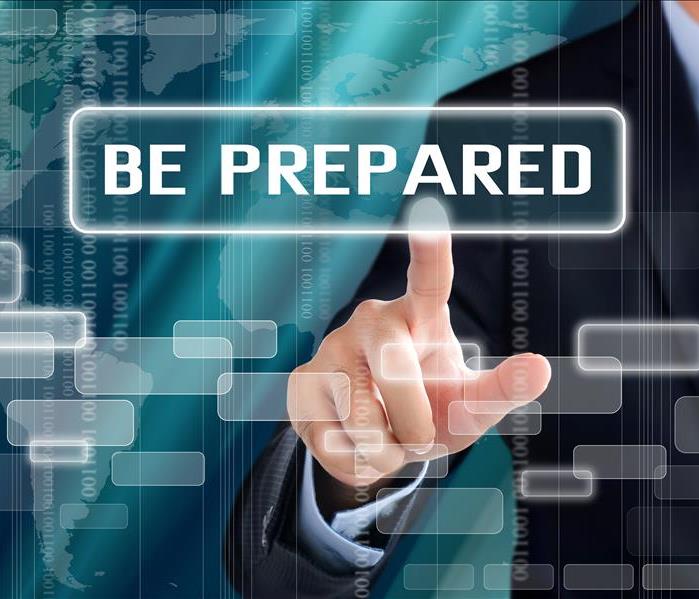 Don't wait until disaster strikes, create your ERP today!
Don't wait until disaster strikes, create your ERP today!
The SERVPRO Emergency Ready Plan is a free service that helps you to prepare for emergencies. The ERP documents all the key information of your commercial business, and it's designed to help the commercial business be prepared for any kind of disaster that might occur.
An Emergency Ready Plan (ERP) is a free service provided by SERVPRO.
The Emergency Ready Plan (ERP) is a free service provided by SERVPRO that provides emergency response services and emergency preparedness services. It's also part of our commitment to helping you prepare your business in case of an emergency.
The plan is designed to help the commercial business to be prepared for any kind of emergency disaster that might occur in your business, minimizing business interruption and downtime as much as possible during an emergency situation.
The ERP prepares your business.
The ERP plan documents all the key information of your commercial business, including priority contact details, property description and location, and insurance information. It will also include vital information about your building, including the floor plans, shut-off valve locations, and priority areas of your property.
The ERP gives you peace of mind.
The Emergency Ready Plan gives you peace of mind knowing that if a disaster happens at any time, SERVPRO will be ready to help you out immediately. The ERP will also provide you with a plan of action to get you back in your building as quickly as possible after a loss.
This plan establishes your local SERVPRO as your go-to mitigation and restoration provider. It also identifies a clear line of command, so both parties know exactly who to communicate with when there is an emergency on your property.
Lastly, the ERP also gives you peace of mind with the insurance claims process. When disaster strikes, SERVPRO will assist you with the entire claims process and collect the documentation needed to ensure you get the proper compensation as quickly as possible.
Why Use the SERVPRO Emergency Ready Plan?
The Emergency Ready Plan is a free tool that allows you to create a comprehensive emergency plan for your business in minutes. It's simple and easy to use, making it the perfect tool for both small businesses and large corporations alike.
- It's a good way to document everything that’s important about your business.
- It's easy to share with other people who are responsible for helping out during an emergency.
- If there’s ever an actual emergency at your property (or even if there isn't), you can use the Emergency Ready Plan as proof that you're prepared for any kind of disaster or emergency situation.
Don't wait until disaster strikes, create your ERP today!
Now is the time to start planning for the next disaster. Don't wait until disaster strikes, create your ERP today! Our SERVPRO team will create an emergency ready plan tailored to your business. Your plan will minimize secondary damage and costs and will help you get back into business as quickly as possible, with one phone call to SERVPRO of Indiana County.
We hope that you are now better informed on what the Emergency Ready Plan is and how it can help your business. If you have any questions or would like more information about this free service, please contact us today!
How To Recognize Mold
1/20/2023 (Permalink)
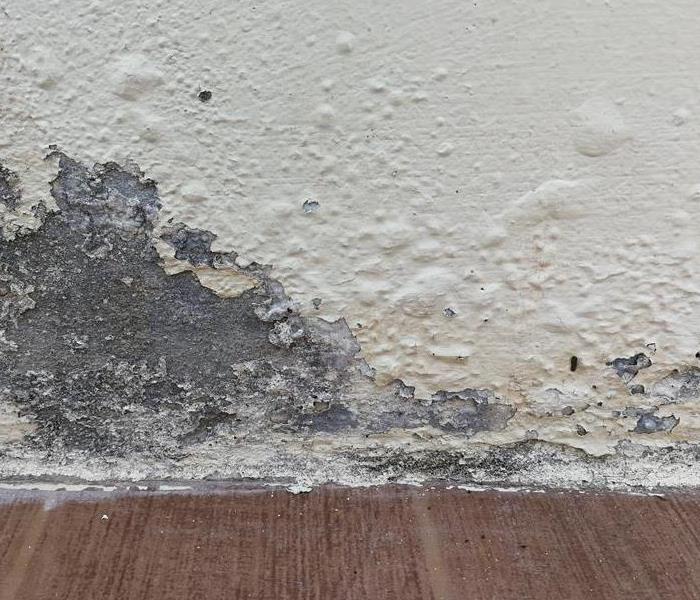 Now that you know what mold looks like, it’s time to take action.
Now that you know what mold looks like, it’s time to take action.
How To Recognize Mold
Mold is a fungus. It's everywhere, and mold infestations are also very common. Most homeowners have experienced a bit of mold at one point or another, but that doesn't mean you should ignore it. Mold is one of the most common indoor air pollutants. Mold grows best in warm and humid environments, such as bathrooms or basements. You may see mold growing on walls, tiles, and even your personal belongings. If you have reason to suspect that your house has mold growth, take a closer look at these signs to confirm what's going on.
If you see some mold in your home, how can you tell if it's dangerous? What does mold look like? How do you know if it goes beyond just being unsightly? And what about the smell—does that mean something too? Here are the two main ways to check for mold in your home or business:
1. By sight
The most common way to detect mold is by sight. If the spot in question looked fuzzy, furry, or powdery, there is a good chance it could be mold. Mold can vary in color, so look for green, red, black, or even white.
2. By smell.
You may not recognize the smell of mold because it's not always strong. There are some subtle smells that could indicate mold in your home:
- A musty odor in the air
- An earthy smell like dirt or hay
- A rotten food odor, particularly near areas where there is moisture from a leaky pipe, leaky roof or window, or an appliance with a wet basement-like smell.
Call SERVPRO of Indiana County
If you suspect that your Indiana County home has been contaminated with mold, it is essential that you contact SERVPRO of Indiana County immediately. Our professionals will come to your home and assess the problem. Then come up with a plan to get your home or business back to normal. We will also begin cleaning up the affected area as soon as possible so that you can return to living in a clean environment as soon as possible.
Now that you know what mold looks like, it’s time to take action. If you see any signs of mold in or around your home, then it is important to get it checked out immediately. This is especially true if you have a family with young children or someone who may be sensitive to mold exposure.
The Different Types of Floods
12/16/2022 (Permalink)
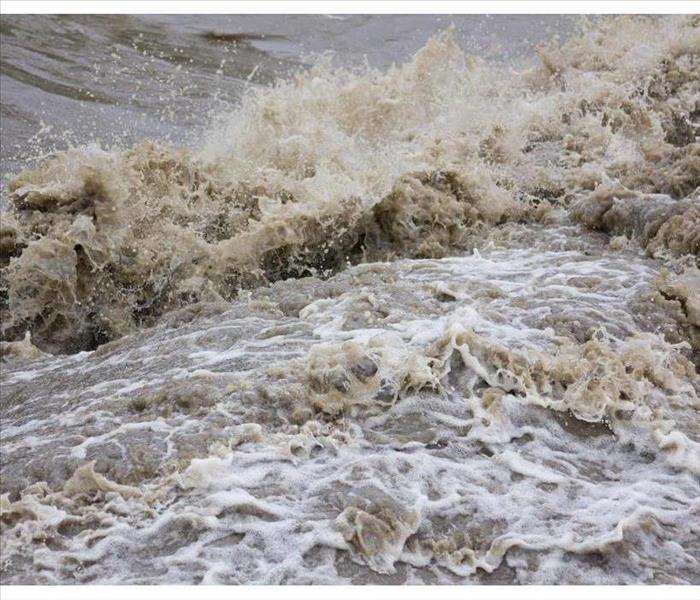 Flash floods may occur after a dam break or waterway failure.
Flash floods may occur after a dam break or waterway failure.
The 4 Different Types of Floods
Floods are one of the most devastating natural disasters in the world. Unfortunately, they can be hard to prevent. A flood is a natural disaster that occurs when an area is overwhelmed by water. It can be caused by any number of factors, including heavy rain, high tides, and extreme weather. Floods can cause damage to property and infrastructure. They can also cause ecological damage, such as soil erosion and pollution of water sources.
Flash Floods
Flash floods are common in arid and semi-arid regions, where heavy rainfall can quickly overwhelm the capacity of rivers to transport water away from their drainage basin. Flash floods may occur after a dam break or waterway failure. Flash flooding is also common during tropical cyclones when high winds move water downstream faster than expected and cause additional erosion, which further increases flow rates.
Urban Floods
Urban floods are caused by heavy rainfall, usually in a storm. The water flows down streets and through poor drainage systems, causing flooding in low-lying areas. Urban flooding can be the most destructive type of flood because of the amount of damage it causes.
River Floods
River floods are the most common type of flood in the US, making up approximately 40 percent of all flood events. They’re caused by rain, snowmelt and ice jams. In fact, river floods can be so severe that they aren’t even considered localized—they become regional or even national disasters.
River floods often occur along rivers with steep banks, which makes it easier for water to flow over its banks and into communities along its path. This is why many areas prone to river flooding are not usually considered high-risk areas for other types of flooding (such as coastal or urban flooding).
Coastal Floods
If you live on the coast, this is the flood you're most likely to experience. Coastal floods are caused by heavy rain or strong winds and can lead to serious damage if your home is built in a low-lying area. Coastal flooding happens when stormwater is unable to drain into the ocean or bay quickly enough because of high tides, strong winds, or storm surges. Storm surges are large waves created by tropical cyclones that can cause flooding even in areas far inland. Even if your home doesn't have any waterfront views, it's important to know about coastal flood risk so you can prepare for an emergency situation and know what steps to take if one occurs.
Floods are a very dangerous and costly natural disaster. They can cause damage to property, injury to people, and may require evacuation from your home. Floods can be devastating, not just for the people that are directly affected but also for the community and economy as a whole. It is important to know what type of flood you're dealing with so that you can have the best chance of staying safe or recovering from it quickly.
About the Institute of Inspection Cleaning and Restoration Certification
11/30/2022 (Permalink)
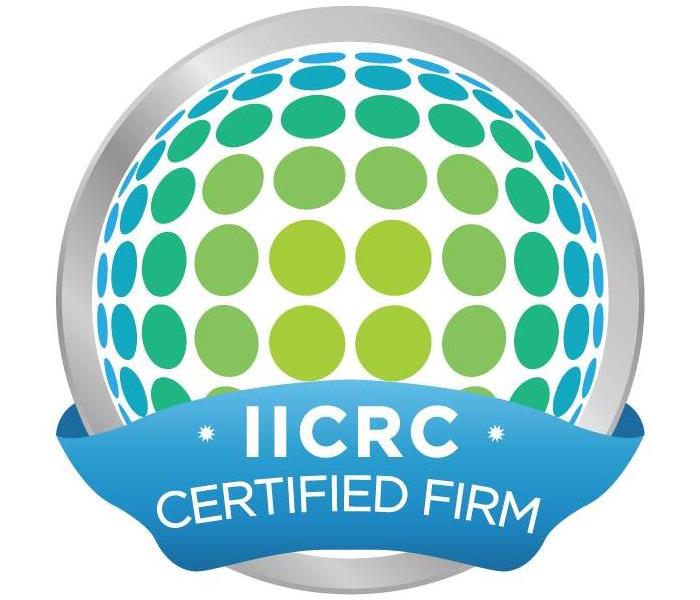 SERVPRO of Indiana County is an ICRC Certified Firm!
SERVPRO of Indiana County is an ICRC Certified Firm!
The IICRC is a non-profit organization that sets standards for restoration companies and businesses across the United States. The Institute of Inspection Cleaning and Restoration Certification (IICRC) is an organization of industry professionals who work in or are interested in these industries and have the necessary certifications. IICRC offers certification programs, educational training and other resources for the restoration industry.
50 Years of Experience
The IICRC has been certifying companies and technicians in all aspects of cleaning, flooring inspection, water damage restoration and mold remediation since 1972. This nonprofit organization is dedicated to improving the skills of the industry through an educational program that teaches best practices for cleaning, restoration and repair.
There are certain levels of certification according to the IICRC:
- Certified Technician: Entry level certification designed for individuals who have little or no experience with cleaning services or who wish to advance their career in this field
- Certified Associate: For individuals looking to expand their knowledge base beyond entry level requirements while maintaining a manageable workload by working within their current company structure as they move towards full-time employment within a professional cleaning service organization
Restoration Industry Standards
IICRC Certified firms are held to a higher standard of business ethics and performance. IICRC's certification programs help businesses build credibility by creating trust with customers. The Institute works to ensure that companies who hold its certifications are committed to providing quality services so that clients feel confident about hiring them for their projects.
When you are looking for a professional to inspect and clean your home or business, it is important to know who is inspecting and cleaning your property. This can be especially important when it comes to the health and safety of your family or employees.
The IICRC certification process ensures that an individual has passed a rigorous testing process and is found competent in their job duties by peers within their industry. It also means that they have agreed to adhere to ethical standards of conduct while on the job. SERVPRO of Indiana County embraces these standards and requires them of our entire team. You can trust that SERVPRO of Indiana County is an IICRC Certified Firm!
Tips for Preventing Water Damage While on Vacation
11/8/2022 (Permalink)
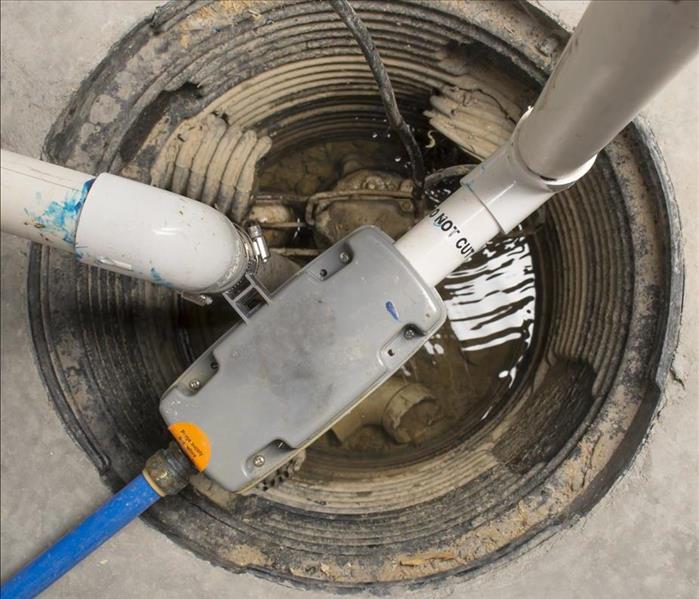 If you have a sump pump, be sure to test it before leaving.
If you have a sump pump, be sure to test it before leaving.
Four Ways To Prevent Water Damage on Vacation
If you don't own a home, you might not ever have to worry about water damage. But if you do, whether it's your primary residence or a vacation rental property, the thought of experiencing water damage is probably terrifying. This guide will help you prevent—and be prepared for—the worst-case scenario: Water damage in your Indiana, PA, home while you're away on vacation.
Shut Off the Water
If you're going on vacation, it's important to be prepared for any eventuality. Water damage is one of the most common and costly problems homeowners face. If there's a possibility that you'll be away from home while your plumbing might spring a leak or flood, take these steps to prevent disaster:
- Shut off the water supply.
- Shut off the breaker for the water supply.
- Shut off the main valve for your house (usually located by either your meter or in an exterior wall).
Check for Pre-Existing Leaks
Before you pack your bags, make sure to check for leaks under sinks, toilets, and faucets. If there’s a leak in the supply line connecting either of these fixtures to the main drainage system, water may continue flowing even when you think it’s off. Check for any signs of mold or mildew on these surfaces as well—this can be an indication that there is some kind of leak underneath them. If you notice any signs of damage or mold growth underneath these fixtures, call a professional immediately so they can determine what the problem is before it causes more serious damage to your home.
Check for leaks around windows and doors, cracks in window frames, water stains on windows or walls, or signs of water damage on the outside of your home.
Take photos of everything. Take pictures of every room in your house to document any visible damage before you leave. You can use this as proof if you need to make an insurance claim later on.
Check Your Sump Pump
If you have a sump pump, be sure to test it before leaving. There are two ways to do this:
1. You can check the float switch by looking at how much water has accumulated in your sump basin (it should be somewhere between 4-6 inches of water). If the float switch has been activated, your pump will turn on automatically and remove the excess water from your basement floor.
2. Check that all of the power sources to your sump pumps are still working properly. This includes checking fuses or circuit breakers for any damage and inspecting any extension cords for fraying wires or broken plugs. The same goes for filters—if they're clogged with sediment from use, clean them out before leaving so that they don't stop up during an emergency situation!
Leave Your HVAC System On
The best way to prevent water damage on vacation is to keep your HVAC system running. This will keep the humidity levels down, prevent pipes from freezing and rusting and help you avoid expensive repair bills when you return home.
If you do find that the HVAC has been shut off while you were away—or if it breaks down later in your trip—remember that there are a few things that can be done to help minimize the damage. First of all, don't panic! Just like when an appliance breaks, don't waste time digging into problem-solving; instead, call for professional assistance immediately. Once they arrive on the scene with their tools and expertise, they'll quickly assess what needs to be done and let everyone know what steps should be taken next so everything runs smoothly again as soon as possible!
Water damage can happen anywhere and at any time, so it’s important to be prepared!
Friend, do not let water damage ruin your vacation. Use these tips to avoid such an unfortunate scenario next time around; they’re simple enough for anyone who follows them regularly at home—so there’s no reason not to follow them while away from home too!
4 Things to Do if You Live in a Flood Zone
8/27/2022 (Permalink)
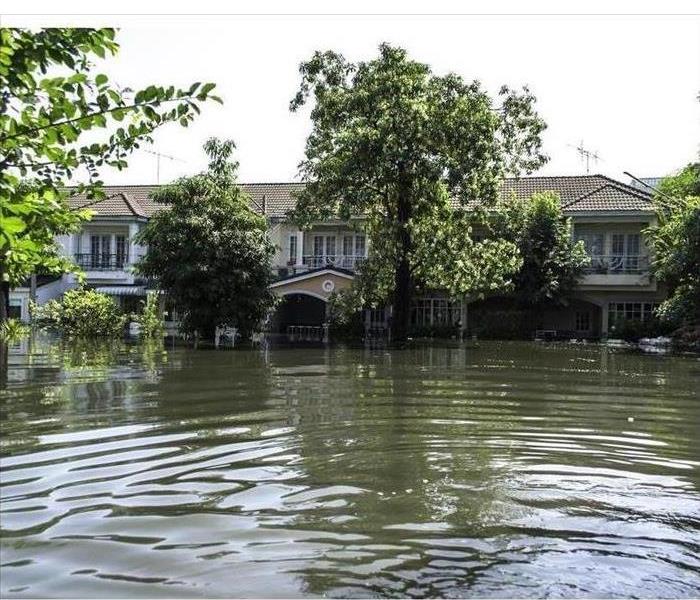 Flood damage in Black Lick, PA
Flood damage in Black Lick, PA
If You Live in a Flood Zone, Here Are 4 Things to Do
If you've ever seen the satellite images of Black Lick, PA, you may wonder why it is laid out that way. However, if you lay a flood zone map over it, you will quickly understand why it looks like that. People who live in high-risk areas need to know how to protect themselves so they don't end up paying the costs associated with hiring a remediation company.
1. Check the Flood Maps
FEMA offers an online tool so you can easily check to see what flood zone your home is in. Through the online portal, you can easily determine your home's risk. These maps are continually changing as different topographical features are altered. Regularly check these, so you are up-to-date on your home's risk.
2. Keep Track of Changes
New construction can easily change a flood zone's risk. Therefore, you need to keep track of nearby changes and note how they impact your property. This can ensure that you are properly prepared for a flood.
3. Buy Flood Insurance
If you are at risk, you need to have flood insurance. This is because flooding is not covered under your property insurance. Flood insurance is available through both private companies and a government-sponsored program. If you choose a private company, you will likely spend a few hundred dollars each year. However, it is worth it to protect you financially.
4. Use Flood Sensors
There are several ways you can protect your home from a flood. One of these is a flood sensor. These are installed throughout your home and let you know if your appliances leak, a pipe breaks, or outside water enters your basement. They can be worked into your home security system. This way, they can send you an alert if water enters your home.
These are just some of the measures you can take to protect your home. Learning more about living in an at-risk area can help you protect your home from storm and flood damage.
How To Maintain Your Swamp Cooler and Prevent Mold Damage
8/27/2022 (Permalink)
 A leaking swamp cooler can lead to mold damage
A leaking swamp cooler can lead to mold damage
How To Prevent Mold Issues In Your Home
Swamp coolers use three-quarters less energy than standard air conditioners but cost only half the price. However, they require more maintenance than central air conditioners do because they use moisture evaporation to cool the air. A leaking swamp cooler can lead to mold damage. Here are three ways to prevent issues so you can keep your White, PA, home cool and comfortable during hot weather.
1. Schedule Regular Maintenance
Even if you don’t see (or smell) any issues, have a licensed professional clean and inspect your swamp cooler. The cooling pads are susceptible to mold growth; replace them halfway through the season. Cleaning the drip pans, ducts and other parts helps prevent the buildup that leads to property damage. Mineral buildup can keep the system from running correctly. Get rid of buildup with descaler tablets or install a filter to remove excess minerals from hard water.
2. Make Repairs Right Away
You don’t want water from your leaking swamp cooler getting into your foundation and causing issues. Replace damaged parts such as hoses, connections and float valves. If the swamp cooler’s reservoir has cracks or holes, water can seep into your home and cause mildew. If you notice your home has mold growth, contact mold remediation experts to clean up the damage.
3. Watch Your Home’s Humidity Levels
Because swamp coolers add moisture to your home, they work best in areas where the humidity is less than 50% during hot weather. If there’s a lot of water in the air, run a dehumidifier or keep your windows open. If you live in an area with high humidity, installing an air conditioner system may be a better option.
When the weather cools down and you’re ready to store your swamp cooler, drain the water supply, clean the water reservoir, let all the parts dry out, and put the unit in a cool, dry space.
What To Expect During Mold Remediation at Your Business
8/11/2022 (Permalink)
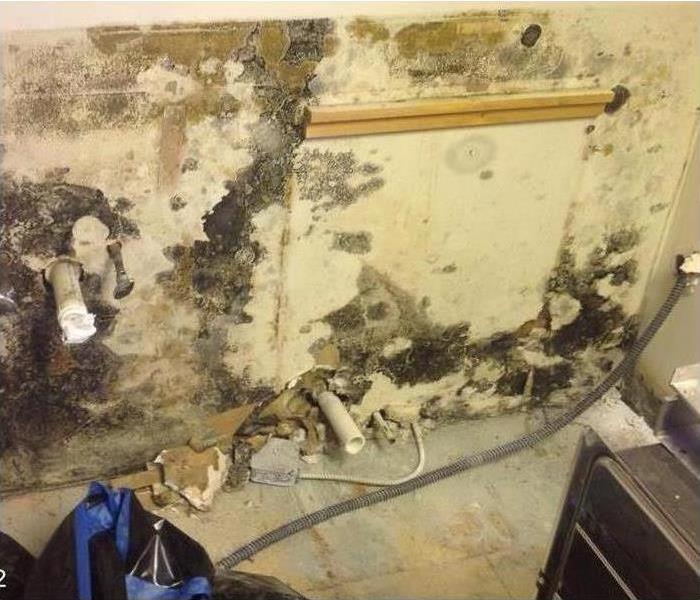 Black mold damage in Black Lick, PA
Black mold damage in Black Lick, PA
What to Expect When Cleaning Up Mold at Your Business
If your Black Lick, PA, business is in need of mold removal after water damage, then it’s recommended that you contact a local mold remediation service. There are several things these professionals will do as part of the process. Here’s what you can expect.
1. Damage Assessment
One of the first things you can expect professionals to do when looking for mold at your place of business is a damage assessment. This will help them determine if mold is present, and how severe it is. This is important as if left unattended mold can eventually turn into black mold which may cause larger-scale damage. Once the assessment has finished they can begin creating a plan for mold remediation.
2. Mold Containment
One of the main steps of the mold removal process is containing the area where mold is growing. This process usually involves sectioning off the space with plastic sheeting, and using a ventilation system to control airflow. The controlled ventilation can be used to help prevent mold spore from becoming airborne and contaminating other parts of the building. Once the controlled environment has been set up, the professionals working on your space can begin the mold cleanup and cleaning of the space.
3. Item Cleaning
After the area affected by mold growth has been contained, professionals working on your business can begin working on item cleaning and restoration. Each item may have a different cleaning method based on the material it is composed of, and what damage it has sustained. Once cleaned these items will be placed into content storage until they can be safely returned to the space.
During the mold removal process it’s not uncommon for the professionals involved to start with damage assessment. From there they will contain any areas affected by mold and begin the repair process and item cleaning. If you have any questions the remediation crew working on your business should be able to help.
3 Ways To Flood Proof Your Home
7/27/2022 (Permalink)
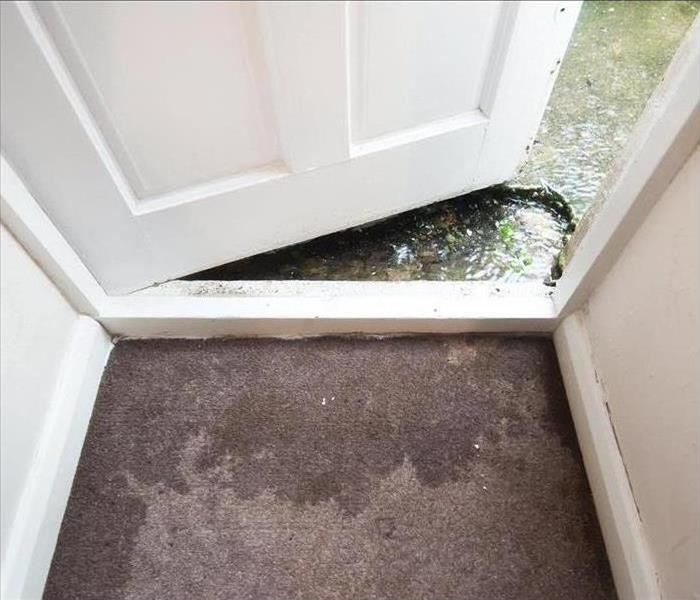 Flood damage in Homer City, PA.
Flood damage in Homer City, PA.
Protect Your House From Flood Damage
Floods are the most weather disaster in America. The heavy rains that accompany hurricanes and other major storms can cause lots of harm to your Homer City, PA, house. In fact, floods caused more than $260 billion in damage to American property between 1980 and 2013. Storms have only become more frequent and powerful since then, so many homeowners are interested in flood safety.
Luckily, there are some ways to flood proof your home. The below steps should help you protect your house from flood damage.
1. Alter Your Water Valves
During a flood, it is not just rainwater that enters your home. Your sewer system could back up, forcing contaminated sewage inside the property. To prevent this, install backflow valves on all of your pipes.
2. Protect Your Climate and Electrical Systems
Any anchored indoor equipment, including your water heater and furnace, should be placed above the expected flood level of your home. Your circuit breakers, switches, wiring and sockets must be elevated as well. For maximum flood safety, they should be at least a foot above the flood level.
3. Elevate Outdoor Equipment
Similarly, any air conditioners, generators or fuel tanks outside your home should be raised and anchored. This is particularly important for generators. After all, if your generator remains on the ground, it could get easily overcome by floodwater.
You should implement most of these measures well before the storm arrives. Yet there are safety tips you can use once the waters start to rise, as well. As the flooding begins, make sure to shut off the electricity in your home. You should also put your major appliances onto concrete blocks and move your belongings to the top floors of the home.
While the above flood safety strategies should reduce the flood damage to your home, the water may still cause extensive harm to your walls and floors. Emergency restoration specialists can repair your house and any items inside of it that are affected by the storm.
What, Exactly, Is a Flood Cut?
7/19/2022 (Permalink)
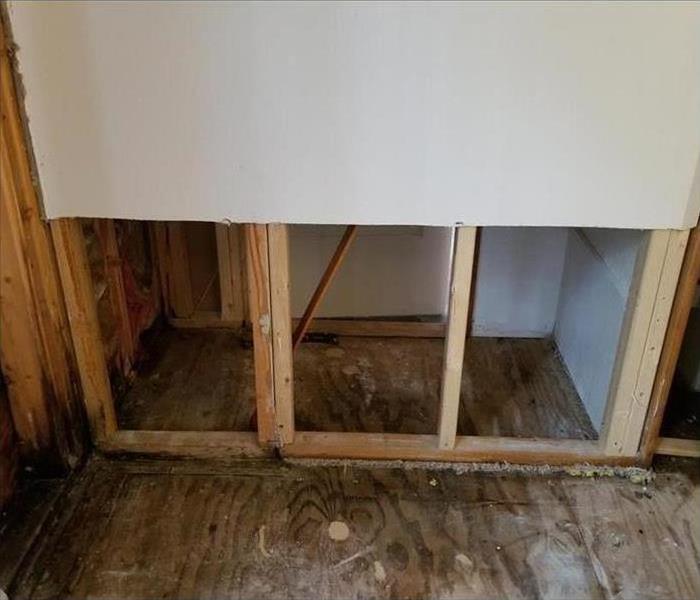 One of the most common procedures performed after severe flooding is a flood cut.
One of the most common procedures performed after severe flooding is a flood cut.
The Aftermath Of a Flood
If you want to give your business the best possible care in the aftermath of a flood, you need to know exactly what your flood restoration company has in store for your building. One of the most common procedures performed after severe flooding is a flood cut, a service performed by professional restoration companies in Indiana, PA, to mitigate damage and restore materials that have already been damaged by the flood waters. There are a few noteworthy things to know about this process:
- It’s done to preserve your business’s remaining drywall.
- It cuts off an additional length of drywall to prevent contamination.
- It’s not always necessary; that depends on the type of flood water.
The Cutting Line
While this process is done to preserve the majority of your drywall, it’s typically not just the damaged materials that are removed during a flood cut. Instead, the restoration crew will begin cutting between 12 and 18 inches above where the water damage ends. This is done so that moisture issues behind the wall can be addressed as well, reducing the likelihood for mold growth and other problems in the future.
Preventing Contamination
Typically, you only need to worry about a tear-out if your flood water is ranked as “black water.” During this type of flooding, the water can be contaminated with bacteria, sewage or other harmful waste, which pose health threats to you and your employees. When dealing with this type of water, it’s always best to perform a flood cut to completely remove the affected walls in order to reduce the likelihood of contamination to the rest of your building.
Dealing with flooding in Indiana, PA, is never fun or convenient. However, by knowing what your building is in for, you can better prepare your business and your employees for emergency situations and restoration work in the years to come.
Best Ways To Extinguish a Grease Fire
7/12/2022 (Permalink)
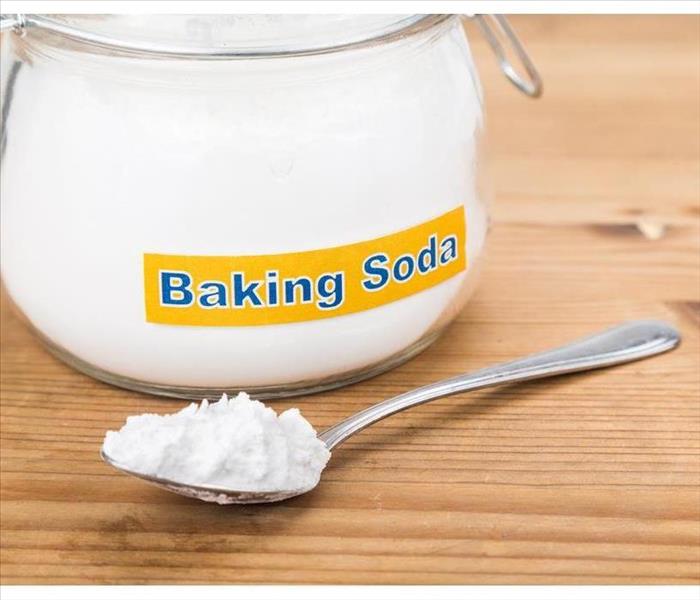 Try pouring a generous amount of baking soda on the flames.
Try pouring a generous amount of baking soda on the flames.
The Best Methods For Putting Out A Grease Fire
The kitchen can be an ideal place to mingle with family and friends. Here, you can cook your favorite dishes and enjoy your creations. A kitchen is also a common place in the home where fires start. One of the most notorious types of fire is the grease fire. This unique challenge can quickly get out of hand and spread. If you don’t know how to properly put it out, you could be in for some terrible consequences.
Cover it Up
If you’re frying or grilling something tasty, but the grease ignites some flames, you need to act quickly before the fire finds its way to other parts of the kitchen and your Loop, PA, home. Your first steps are critical.
- Grab a nearby metal lid and place it over the top of the flames.
- Use a cookie sheet to cover the area where the fire started.
- Leave the lid or cookie sheet in place until it is cool.
Do not use Water
As a child, you learned water can quickly put out fires. However, this isn’t the case with grease fires. In fact, this can cause the fire to spread. If you have a grease fire, never use water.
Try Baking Soda
Hopefully, you’ll have some baking soda in the cabinets of your kitchen. If covering the fire isn’t working, or if the fire has gotten too large, try pouring a generous amount of baking soda on the flames. This should smother it and extinguish the flames. This will make your fire cleanup a little messy, but it will save you extensive damage and heartache. It’s important to not use similar materials such as flour or baking powder.
No one wants to see a grease fire at home. The good news is that if you know how to act promptly by using these strategies, you can put an end to the fire before it causes major problems.
An Overview of Category 2 Water Damage
6/30/2022 (Permalink)
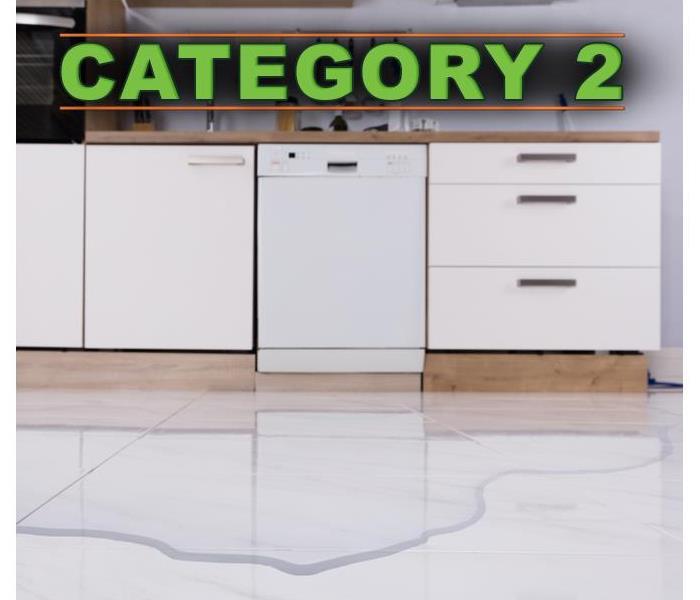 Category 2 water damage comes from a dirty water source.
Category 2 water damage comes from a dirty water source.
A Quick Guide to Category 2 Water Damage
Water damage in your workplace can have many causes and effects. You may need to do some water pipe repair or rebuild the entire building. What the water damages can be problematic. In addition, the type of water you have in your White, PA, building is worth noting. Category 2 water damage, for example, is more serious than Category 1. It is helpful to understand what this type of water damage is and the issues it can cause in your workplace.
1. The Basics of Category 2 Water
Category 3 water is flooded water from sewage sources that contain human waste. And while Category 1 water is clean water, Category 2 water is clean but sits too long. For example, when water floods through the building from a higher level to a lower one, it will be Category 2 water. When this occurs, the water passes through different building materials.
2. What to Look For
Category 2 water can come from broken pipes, washing machines, and dishwashers. It is often referred to as "gray water." This type of water can carry microorganisms and contaminants. If you have Category 2 water in your office following a flood, do not touch or ingest it.
3. Cleaning up and Doing Water Pipe Repair
If you do have this type of water in the workplace, shut off the source of the water if it's safe to do so. If a pipe breaks, call a plumber right away to fix or replace it. You'll also want to call a water cleanup company to address the damage following the flood. Technicians from the company will remove the water and clean up the damage it caused. This includes cleaning contents such as documents, flooring, furniture, and electronics. The company will also tear out damaged building materials and replace them. Water pipe repair is challenging enough, but cleaning up after Category 2 water damage can be extensive. Fortunately, there are ways to recognize this type of water and restore your workplace.
Why Business Insurance Is Essential for Protecting Your Investment
6/14/2022 (Permalink)
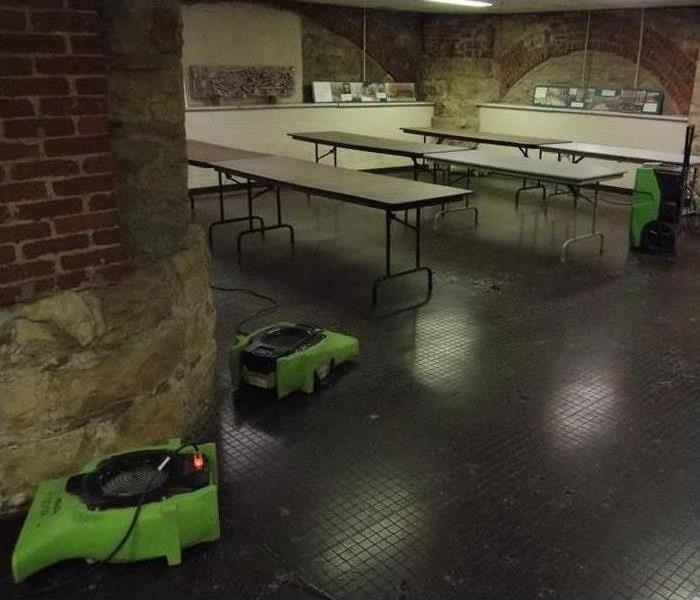 Water cleanup in a museum in Iselin, PA.
Water cleanup in a museum in Iselin, PA.
Faulty plumbing, structural problems, and natural disasters can lead to costly water damage that can pause operations at your business in Iselin, PA. However, business insurance can pay for the drying and restoration efforts to minimize your losses and prevent you from closing your doors.
What Can Cause a Flood at Your Business?
Excessive amounts of water can quickly saturate your business's interior spaces when:
- A storm causes holes in your roof, allowing rain to enter
- A malfunctioning sprinkler system emits water without a fire to extinguish
- Your old plumbing system has a broken pipe
- The drainage system around your business's exterior is inadequate
- Toilets and sinks overflow
What Type of Water Damage Does Business Insurance Cover?
Commercial business property insurance policies cover many types of physical damage but will only cover water-related damage involving leaks and broken pipes. In addition, property damage due to flooding following natural disasters or negligent property maintenance is exempt from coverage unless business owners purchase separate policy riders to cover these circumstances.
What Type of Coverage Riders Are Available?
You can still obtain insurance to help you pay for flood damage that your commercial property insurance does not cover. For example, commercial flood insurance will pay for water cleanup and restoration services to dry your business's interior environment and essential equipment, documents, electronics and furnishings when natural disasters lead to internal flooding. In addition, when the damage to your property leaves it unsalvageable, commercial flood insurance can help you meet replacement costs.
Business continuation riders can help you pay your employees' salaries and the cost of relocating temporarily while disaster recovery services dry out your space and restore it to its pre-disaster condition.
Business insurance protects your property and investment in Iselin, PA, from water damage following unpredictable disasters and frequent system failures. However, you must purchase the appropriate coverage that considers multiple risks.
Tips To Make Filing an Insurance Claim Easier
6/1/2022 (Permalink)
 Our team of restoration professionals will respond immediately when you need us most.
Our team of restoration professionals will respond immediately when you need us most.
Making an Insurance Claim Less Difficult
Filing a commercial insurance claim can seem like an intimidating process, especially if you haven't been down this road before. By following a few important steps, though, you are likely to find the experience not all that difficult. The end result is that the process will be efficient with fewer frustrations and your company in South Bend, PA, will get the payment it deserves in a timely manner. This is especially important when you are dealing with the impacts of a water, fire, or storm emergency. The first step is to use a SERVPRO franchise in your area, as this leader in restoration services, located in nearly 2,000 communities in the U.S. and Canada, is a preferred vendor for many insurance companies.
Working With Insurance Professionals
You will probably be pleased to find that those who work in the insurance field are looking to provide you with the best service possible. Your insurance agent wants to keep your business, and that means following through on the benefits you have earned by paying insurance premiums. To make the process run smoothly, keep these best practices in mind:
- Provide honest and timely information
- Work with a commercial damage restoration franchise
- Follow an established claims inventory service
- Partner with established professionals
- Work with a team that has certification standards
Filing the Insurance Claim
The paperwork for a claim will be less burdensome for your company when working with a restoration company that plays a close role in all insurance matters. You will not need to reinvent the wheel and take a lead role in the process. You can expect vendor qualification compliance and professionalism from beginning to end. Not only will your facility be restored to its original condition after a disaster, but you will also reap the financial benefits of working with professionals. Filing a complete and accurate insurance claim helps keep your company strong during challenging conditions.
Why Is Water Damage Present After a Commercial Fire?
5/23/2022 (Permalink)
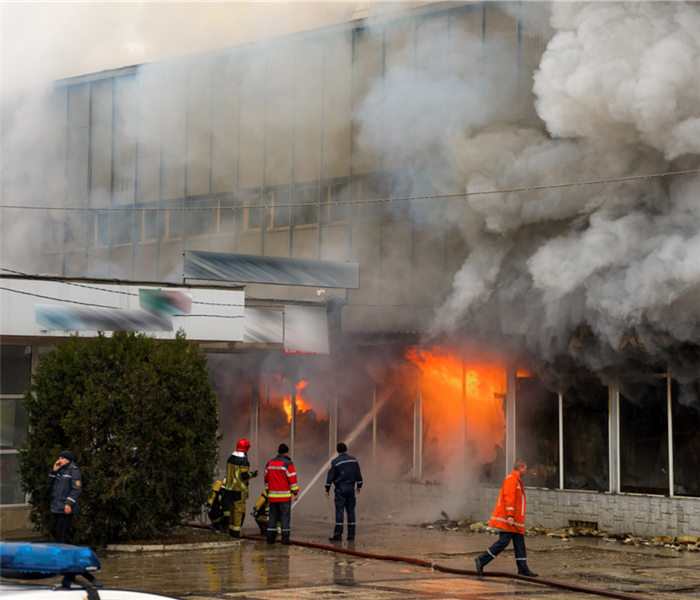 Water used by firefighters is the most common after extinguishing a fire.
Water used by firefighters is the most common after extinguishing a fire.
After a Commercial Fire, Why Is There Water Damage?
When your Canoe Ridge, PA, business is affected by fire, you might expect fire damage such as smoke, soot and ash, along with property damage and weakened structures. However, you can also find a surprising amount of water throughout the area. Find out more about why this damage appears, how it affects your business and how to respond to it.
Causes of Water Damage
Despite the overwhelming presence of fire and the residue, it leaves behind, some of the damage you might see in the aftermath can involve water. The most likely causes behind this impact include:
- Fire hose water
- Fire sprinkler system
- Damaged water pipes
- Destroyed water containers
Water used by firefighters is the most common since they use several gallons to extinguish the fire. Meanwhile, sprinklers are set up to use water more efficiently and leaks from pipes and containers are less frequent.
Consequences of Excess Water
While the present fire damage is understandably the main concern, the effects of water on your property can be just as devastating. Wooden flooring can warp once it dries, while the wet carpet is difficult to repair, especially when it is combined with other contaminants. Drywall can become vulnerable and need replacement, while weakened ceilings can endanger the rest of your building. Additionally, if the water is not removed fast enough, you could risk a mold infestation.
Possible Solutions to Damage
You can avoid all of these risks by working with commercial building restoration services. These qualified technicians are already familiar with all types of business property damage, so they can treat fire and water-based destruction. They can fix or replace affected flooring depending on the severity. Damaged drywall and ceilings are carefully inspected and replaced to keep the structure sound. Vacuums, sump pumps and more resources are used to dry and clean surfaces, preventing mold.
Water can be just as impactful as fire damage, especially when it is not detected and treated on time. The best remediation strategy can anticipate and address all sorts of damage to improve your business over time.
How To Find a Shower Leak
5/21/2022 (Permalink)
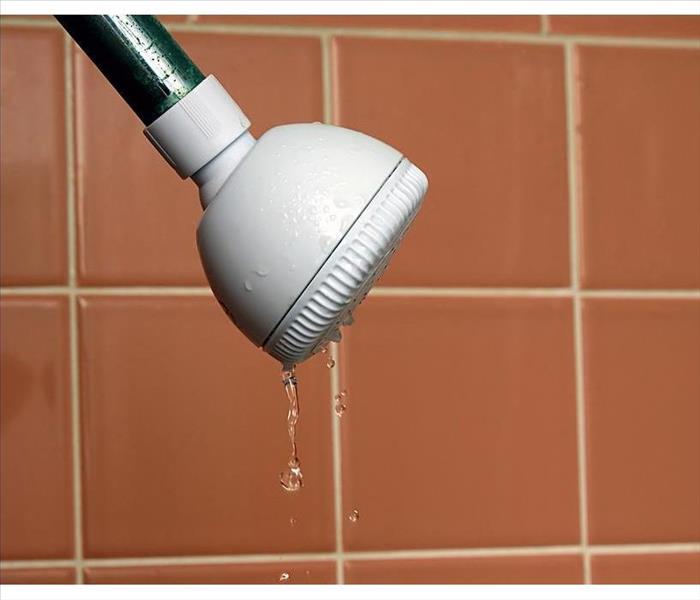 A leaking shower or bathtub can cause a lot of problems in your home.
A leaking shower or bathtub can cause a lot of problems in your home.
A leaking shower or bathtub can cause a lot of problems in your home in Willet, PA. To make matters worse, many leaks go undetected because they are difficult to spot. The good news is that if you know what to look for, you can reduce the risk of water damage.
How To Spot a Shower or Bathtub Leak
In a bathtub or shower, there are a few main areas where water is likely to leak.
Faucet - A leaky faucet is one of the most common sources of bathroom leaks. Since they are easy to spot, the issue can be resolved before it creates a huge problem.
Grout - Leaks in the grout are fairly easy to find as well. Look for water seeping in gaps or cracks in the tiles and grout. If the tiles always seem damp or waterlogged, mold may be growing below the surface.
Body of the Bathtub - A bathtub leak is more difficult to detect. Dry the outside of the tub and then wrap newspaper around it. Fill the tub with water and look for areas of the newspaper that get wet quickly.
Shower Pan - Look for signs of wear or cracks to determine if there is a shower pan leak. Replace if needed.
How To Fix a Bathtub Leak
Some leaks are easier to fix than others. For a leaky faucet, replace the gaskets and stem washers inside the faucet. Remember to turn off the water supply before you begin.
If you have a tile grout leak, apply a heavy sealant to the grout after drying the surface. A leaking bathtub body should be inspected by a professional plumber.
If you discover water damage, mold can be growing behind the fixtures. Contact a water restoration professional as soon as possible.
Reduce the risk of water leaks in your bathroom by knowing what to spot.
Preventing and Removing Ice Dams
5/16/2022 (Permalink)
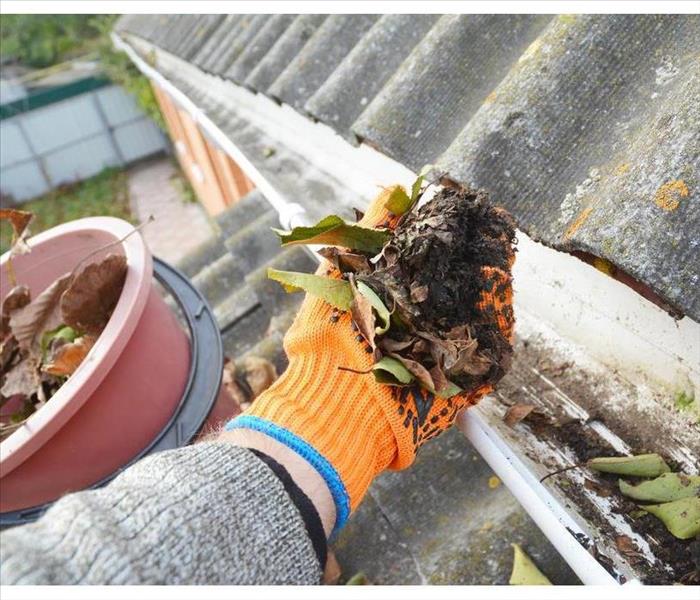 Keep your gutters and downspouts clean.
Keep your gutters and downspouts clean.
Ice Dam Prevention and Removal
The winter months can be incredibly challenging for homeowners. The winter brings new threats like snow, ice, and even the unique problem of a potential ice dam. Still, according to storm remediation services in Two Lick, PA, homeowners can do plenty of things to protect their roofs and properties from such issues.
1. Ensure Gutters and Downspouts Are Clean
Before winter storm season is even upon you, it is beneficial to clean out gutters and downspouts. Clogged drainage systems can prevent snow and ice from melting correctly. The gutters can flood and freeze, meaning melting snow will only back up and freeze under shingles, forming ice dams and potential leaks.
2. Use Roof Rakes
A roof rake is an effective way to remove excess snow from the roofline. The tool can resemble a long garden hoe or rake, and it is used to pull excess snow off the roof. Remember when using a roof rake that clearing the roof entirely of snow is unnecessary. You primarily want to eliminate snow from the first one or two feet above the gutter, providing plenty of room for it to melt.
3. Use Heat To Melt an Ice Dam
One tool often used for ice dam prevention is gutter wires or coils. Essentially, these tools are heating elements. They do not heat to dangerous temperatures, but you should still be careful whenever using heat against a wooden structure.
4. Use Ice Melt
You can also use ice melt to remove or prevent the development of ice dams. Many professionals recommend placing the ice melt in a nylon sock and setting it on top of a dam or in a gutter to prevent a dam. The goal is to create a channel through the ice to allow water to evacuate the roof.
An ice dam is a common problem in colder regions, but it is not an impossible one to resolve. Following the steps above should help you avoid any trouble with dams in the future.
3 Steps to Take in Case of a Flood on Your Commercial Property
4/22/2022 (Permalink)
 Contact your insurance.
Contact your insurance.
Three Steps To Take In Case Of a Flooding
Flood damage is a common and devastating experience for property owners in Black Lick, PA. If you have experienced a flood in your building, you can take action immediately to prevent damages from worsening with time. Some common reasons for flooding include:
- Burst pipes
- Heavy rainfall
- Sewage overflow
The type of flooding in your building will determine what action you should take for cleaning and reparation. Here are three steps to take in case of a flood.
1. Determine the Type of Water
There are three categories of water from flooding. They determine the risk of hazard for bacterial and viral illnesses from contact with the water. Category 1 is sanitary water which normally comes from water supply lines. This water is drinkable and safe to clean without protective gear. Category 2 water is somewhat dirty and includes water from showers or washing machines. Category 3 water, or black water, is highly unsanitary and should be handled with care. Flood water from storms falls into his category.
2. Clean As Much Water As You Can
Time is important when water enters your property. Water that is allowed to sit on your property can dampen natural construction materials and furniture, increasing the risk of irreparable flood damage. Clean the water with rags, towels, mops, and any other tool that can sop up the moisture. If you are handling black water, use protective gear. You may want to hire a storm damage restoration service to aid in the cleanup of Category 3 water and restoration of your property.
3. Contact Your Insurance
If you have flood insurance, they can provide you with a list of providers to aid in cleanup and repairs. They will often cover storm damage and sewer backup if it affects more than two acres of land. Contact your insurance company before hiring a contractor to help with restoring your property to prevent overspending.
Flood damage may not always be preventable but being prepared can make a great difference in costs and loss. Know what steps to take and lessen the damages made to your property by a flood.
5 Myths About Polybutylene Plumbing
4/13/2022 (Permalink)
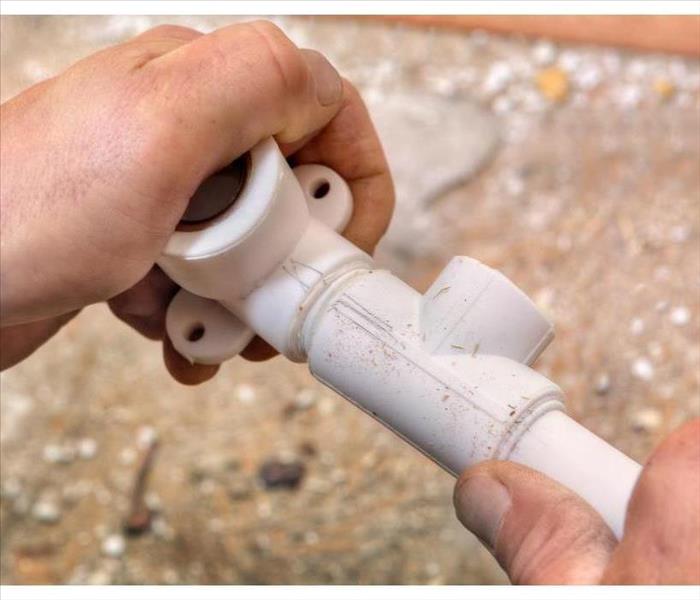 Most polybutylene systems won't fail for years.
Most polybutylene systems won't fail for years.
Polybutylene Plumbing: 5 Myths
If you are running your business out of an older building, chances are the plumbing is using some materials of questionable integrity. Here are some myths about one particular material that may convince you it is time for new plumbing.
1. Only Pipes With Plastic Fittings Experience Problems
This is not true. Your system may have metal fittings, but that doesn’t mean it won't fail. This is because systems with metal fittings still contain polybutylene pipes and plastic valves, which can fail. However, systems with plastic fittings have more components that can break and have a greater failure rate. Basically, it is a classic bad versus worse scenario.
2. Replacing Them Is Expensive
Replacing older pipes costs roughly the same as putting in new carpet or redoing the roof. To put this cost into perspective, it is usually cheaper than replacing all of your windows or waterproofing the basement. However, this is contingent on you using a re-piping specialist. While it can be an unexpected cost associated with a business, it can prevent you from needing water restoration professionals.
3. Everything Is Covered Due to the Class-Action Settlement Fund
The class-action settlement was very generous. However, it doesn't cover everything. There are serious limitations on free pipe replacements in Homer City, PA.
4. Problems Occur Due to Poor Installation
While installation problems can occur with polybutylene pipes, this is not the main problem. More common factors include degraded fittings, water quality issues, chlorine levels, and age. One or more of these factors can contribute to a failure over time. In other words, even those that were installed perfectly are still susceptible to failure.
5. These Pipes Have Lasted 10 Years, so They Are Still Good
This is not true. Most polybutylene systems won't fail for years. In fact, it usually takes about 10 years for leaks to develop.
Like many business owners, you probably want to avoid water damage in your building. If this is the case, you should consider these common myths about older pipes and whether you should replace yours.
Business Owners Should Expect Experts To Do These 3 Things During Mold Remediation
4/5/2022 (Permalink)
 Black mold damage in Indiana, PA.
Black mold damage in Indiana, PA.
Mold Remediation Process
One of the major concerns about water damage is moisture's ability to trigger black mold growth. Business owners may go from dealing with a broken pipe or toilet overflow to being told that fungus has infested the space. When this happens, proprietors should prepare for several stages of cleanup. To minimize the spread and restore the building, owners should expect to see the following three things.
1. Block Off the Contaminated Space
A water remediation company in Indiana, PA, must start mold cleanup by cutting off the microbes' ability to migrate. After a thorough inspection, the experts determine what is harmed. They cut off the area from foot traffic and set up negative air chambers to stop airflow. It's best not to enter the space, allowing only the professionals to enter and leave. They wear protective gear to limit exposure levels.
2. Remove Moisture Promptly
Black mold feeds on water, so specialists perform a meticulous inspection to see how much dampness is present. With the supply stopped, the reproduction begins to slow down too. Moisture reading tools inform specialists about troublesome spots, guiding the team as to where to start extraction and drying procedures.
Carpet and drywall are concerning since they are porous substances that cannot be treated with chemicals. Tear out these items to reduce wetness and spore count. Flood cuts are made, usually a few feet above the waterline, to ensure proper cleanup. Industrial dehumidifiers run around the clock. These devices extract moisture from the air and materials, quickening the drying time.
3. Sanitize What Is Left
Once aired out, the mold remediation crew washes the rest of the interior and applies an antimicrobial spray. These work effectively on non-porous substances, killing lingering microbes. Content cleaning crews use high-tech equipment to tend to electronics and valuable documents.
Water damage may easily lead to black mold, so it's imperative to act immediately. Secure the impacted areas, and focus on getting these locations dry. With the help of professionals, owners can hinder mold development and restore the property.
3 Types of Mold Damage Your Home May Experience After a Flood
3/28/2022 (Permalink)
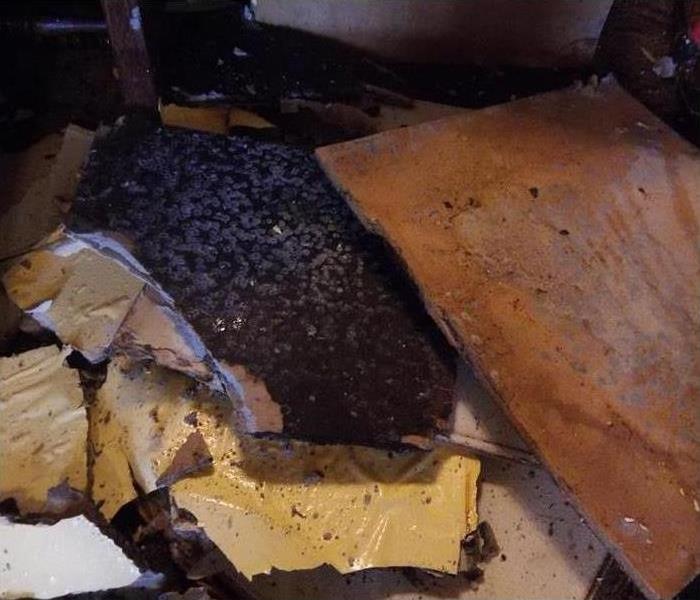 Mold can grow anywhere moisture is present.
Mold can grow anywhere moisture is present.
The Aftermath Of a Flood In Your Home
Whether the source was rising outdoor water levels or from a backed-up toilet, flooding can cause serious problems for your White, PA, home. One result of flooding may be spreading silently and causing considerable damage: mold growth. If you are working to recover from a flood, being able to spot the warning signs of fungi could help you prevent serious and costly problems later on.
1. Ceiling Stains
Mold often grows where you cannot see it, which means you may not be aware of its presence until it has already taken hold of your home. However, ceiling stains may indicate the presence of moisture and mold, as spores often attach where there are humid, moist conditions. If you notice these stains, you might want to have your ceiling opened and checked for mold as soon as possible.
2. Damaged Interior Walls
Drywall and other porous building materials tend to absorb standing water after a flood, making the interior walls a perfect environment for mold growth. Once fungi start to form, they can eat insulation and ruin any wiring that might be present behind the walls. Even if you experienced a minor flood in a room with drywall, you might want to ask for storm damage and flooding technicians to perform a flood cut, which opens a section of wall above the flood line and can alert you to the presence of any mold.
3. Stubborn Musty Smells
The formation of the black mold is often common after a flood, especially if the floodwaters were contaminated with sewer products and other bacteria. Because this type of fungi tends to grow quickly, it can create stubborn musty odors that may be difficult to eliminate. A flood mitigation and cleanup service will likely be able to give you a variety of options for odor removal.
The aftermath of a flood in your White, PA, home can be a considerable cause for worry. However, learning to spot possible signs of mold growth and the damage it may be causing could help you prevent future problems.
How Fire Sprinklers Work During a Fire
3/23/2022 (Permalink)
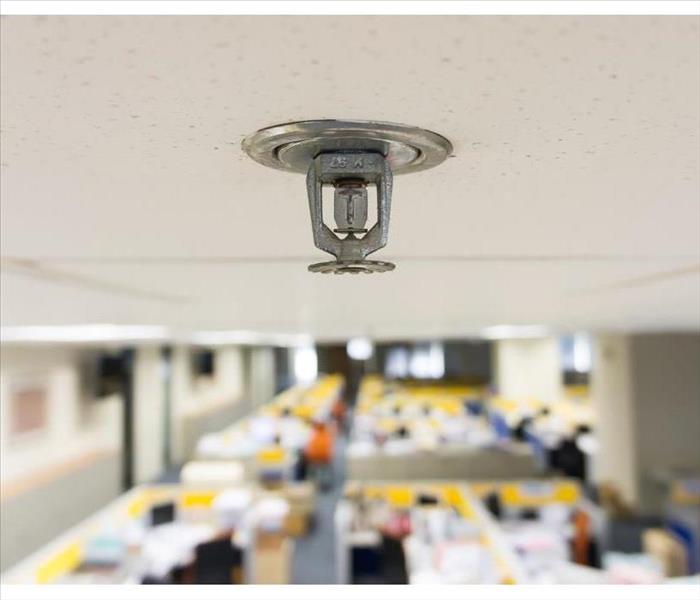 In the event of a fire, a reliable fire sprinkler system can save lives.
In the event of a fire, a reliable fire sprinkler system can save lives.
How Do Fire Sprinklers Work?
In the event of a fire, a reliable fire sprinkler system can save lives. Equipping your commercial building in South Bend, PA, with sprinklers also significantly reduces property loss and damage. To protect all of your employees and keep your building safe, it’s crucial to have a fire suppression system installed and functioning properly. Here are the different ways a sprinkler works to extinguish a fire.
Detects Heat
While the presence of smoke sets off a smoke detector, sprinkler systems are mainly triggered by heat. As soon as a spark appears, the following takes place:
- Air surrounding fire heats up
- Heated air rises towards ceiling
- Sprinkler head senses heat and activates
Detecting heat is an essential feature of a fire sprinkler because it enables it to drown out the fire as soon as possible. Making sure your system is in good shape is necessary in order to be prepared for a real fire.
Douses the Flames
Once the sprinkler has sensed heat around it, it releases pressurized water. The water comes from a pipe system that connects to a water source outside the building. After heat causes the sprinkler to activate, a valve in the sprinkler head opens and water flows out. Because the water is pressurized, it is able to douse the fire completely and ensure that it is safely extinguished.
Keeps Water Confined to Area of Fire
When the heat rises towards the ceiling, only the sprinkler head closest to the heat source activates while the other sprinklers stay sealed. This can prevent excessive water damage from harming your building. However, the water that flows from the one or two active sprinklers can still cause harm to your building, which is why it is vital to contact a professional and schedule a fire sprinkler cleanup immediately.
If your building in South Bend, PA, has water damage as a result of fire sprinkler activation, don’t wait to call for help. A water damage repair specialist can help restore your business in no time.
What To Do After Water Damage
3/7/2022 (Permalink)
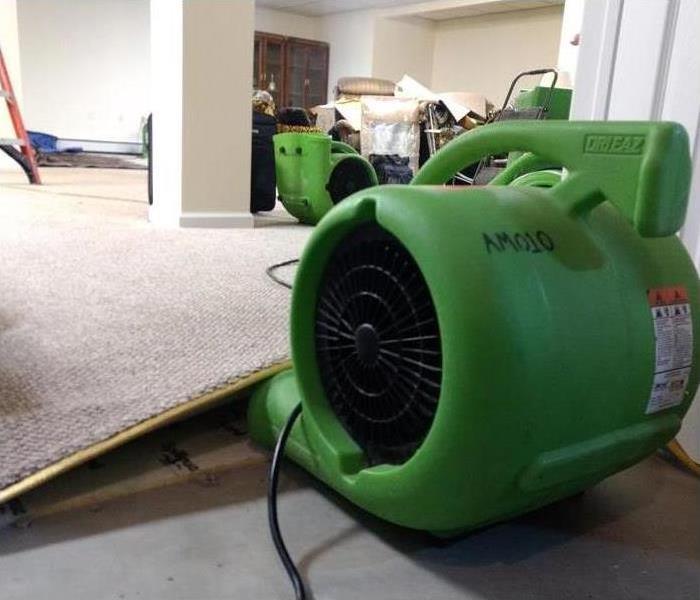 Air movers are being used to dry under the carpet after water damage.
Air movers are being used to dry under the carpet after water damage.
Water Damage In Your Commercial Building
Any type of water damage to your commercial building in Loop, PA, can bring stress and confusion during the restoration process. Whether it is from broken pipes or a natural disaster, sometimes this damage is inevitable. However, knowing what to do in these emergency situations can not only keep yourself and others safe but help your building avoid lasting damages. Follow these five steps to figure out how to move forward and get your building back to its original state.
1. Shut Off the Water Source
When possible, it is important to find the source of the water and shut it off. This may mean turning off the main water source to your building. However, in cases of flooding, this may not be possible.
2. Remove Excess Water
After you have stopped the source, you should begin to remove any excess water. You can use a mop to do this or lay down towels to cover a larger area. If there is too much to handle easily, a water restoration service can help with removal.
3. Remove Furniture
If any pieces of furniture have been affected by water damage, it's important to remove them and get them professionally dry-cleaned as soon as possible to avoid lasting damage. This also includes any upholstery cushions. Any building materials that have been damaged by the water should be dealt with by a professional restoration company.
4. Place Wood Blocks Under Furniture Legs
By placing wood blocks or aluminum foil under furniture legs, you can lessen the amount of damage that the water does to these objects.
5. Be Mindful of Ceiling Fixtures
In the event that your building's ceiling has been damaged by water, be sure to not turn any ceiling fixtures on.
Water damage to your commercial building can be complicated and costly. Using these tips can help you deal with the damage quickly and make the water cleanup process easier.
3 Reasons Why SERVPRO Is the Best Choice After a Storm
2/23/2022 (Permalink)
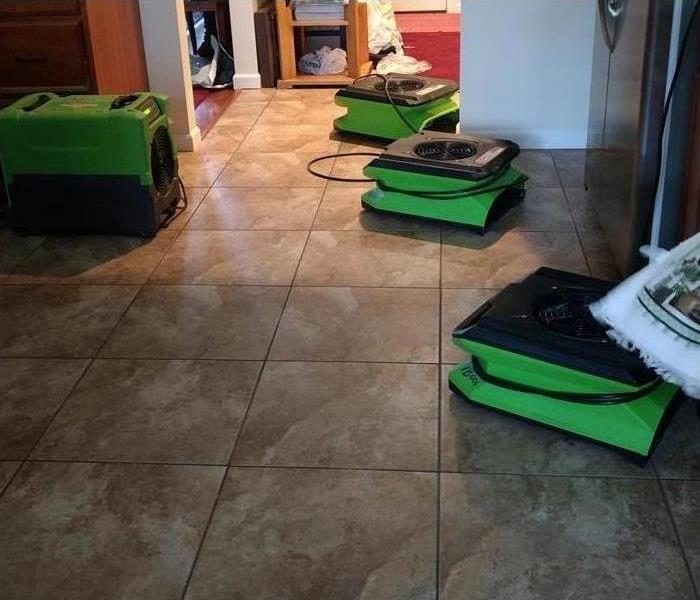 When there was a lot of water on the floor, SERVPRO was there right away.
When there was a lot of water on the floor, SERVPRO was there right away.
Why SERVPRO Is the Best Choice After a Storm
If you have experienced a storm in Iselin, PA, there will likely be some damage to buildings in the area. When you need the help of a storm restoration service, SERVPRO is a preferred company for many insurance agencies. Here are a few reasons why choosing them is best for you and your clients.
1. Many Clients Could Be Affected
After a storm, you may have multiple clients with damage to their homes. Dealing with several insurance claims at once can be stressful and time-consuming. SERVPRO can make the storm restoration process go more smoothly. They have over 1,700 locations that are open 24 hours a day and 365 days a year, so they will be available as soon as you need them.
2. A Quick Response Means Less Damage and a Faster Claims Process
When a client has water damage in his or her home, it is important to act quickly. This kind of damage will only get worse over time if it is not taken care of, so a quick storm response can make a big difference. They can inspect the home within hours of your call, so you can process your client’s insurance claim more quickly. This also allows the company to begin mitigation to prevent further damage, which can save both time and money during the restoration.
3. They Are Faster to Any Size Disaster
Whether a client has a lot of flood damage in the home or a little, SERVPRO is trained to handle it. They have both the equipment and the experience to respond to emergencies of any size. You can expect the job to be done as quickly as possible without sacrificing the quality of work.
When you need to provide storm restoration to a large number of clients, choose a damage restoration company with a fast response and highly trained workers. This will make the process easier on everyone involved.
Top Tips for Avoiding Secondary Flood Damage
2/21/2022 (Permalink)
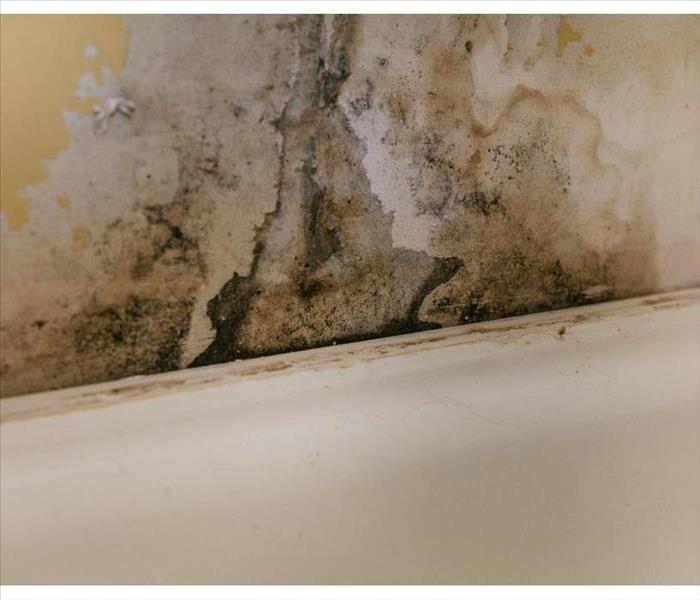 Water damage can lead to mold growth in your property if not taken care of quickly.
Water damage can lead to mold growth in your property if not taken care of quickly.
Tips For Avoiding Secondary Damage
When water rises in your home, that can be scary enough. The water on the ground is not the only concern for homeowners dealing with flooding, however. You should also take steps to avoid secondary damage like black mold. While the water itself is the primary problem, other issues include:
- Mold on the walls and floor
- Mold in porous belongings, like furniture
- Mildew in any part of the room
- A musty odor
Quick thinking can save you from having to deal with these problems after a flood. Here are a few tips for avoiding secondary damage.
1. Call a Restoration Crew Immediately
There are professional restoration companies in Canoe Ridge, PA, that are open 24/7 and ready to help. As soon as you notice flooding in your home, you should give them a call. Every hour that passes until someone removes the water allows black mold to spread.
Why is it important to call immediately? As the water sits in the room, it causes high humidity. The water evaporates into the air and has nowhere to go so that it can get into the walls and other porous areas. This moisture can cause mold in places that the original flood never touched.
2. Remove Porous Belongings
Once the restoration crew has removed the water and says that it is safe for you to enter the room, you should remove clothing, upholstery, and any other soft items. Allow these belongings to air dry either outside or near an open window.
3. Clean Thoroughly
The restoration crew in Canoe Ridge, PA, should clean the room where the flooding occurred. However, you may need to ensure that mold and mildew are not on the items you removed. Once these belongings are dry, you can clean them with disinfectants. If you had any hard surfaces in the room, you might wish to clean those as well.
Flood waters are a problem, and the potential secondary damage can be a nightmare. Prevent the black mold from high humidity with these tips.
First Aid Kit Requirements for the Workplace
2/16/2022 (Permalink)
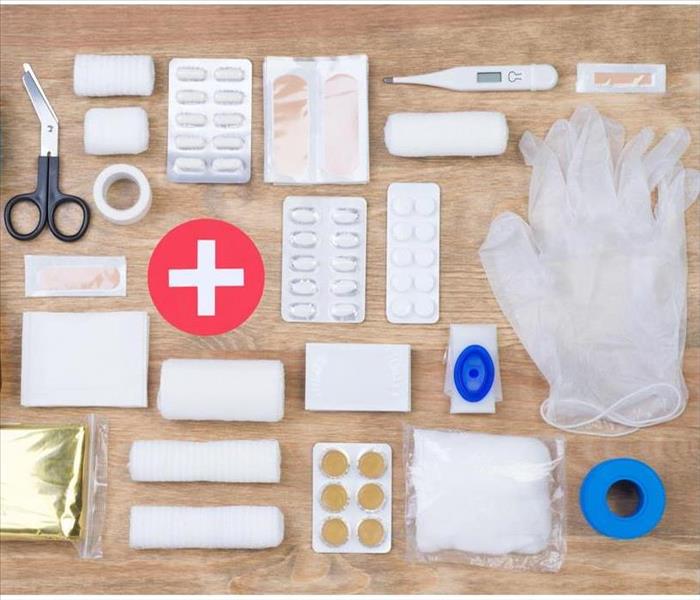 A first aid kit is a critical part of a safe working environment.
A first aid kit is a critical part of a safe working environment.
First Aid Kit
Most would agree on the importance of being prepared for emergencies. In the event that first aid is needed, a well-stocked kit is a must. Many people may not realize that OSHA actually requires that all workplaces have a first aid kit on site, and larger spaces are mandated to have multiple ones available. If you own a commercial building in Willet, PA, read on for information on the supplies you need to have on hand.
Stocking First Aid Supplies
In addition to equipment for resuscitation and directions for obtaining emergency assistance, there are a variety of supplies that should be available to employees. At a minimum, worksites should provide the following items in an emergency kit:
- Scissors and medical tape
- Latex gloves
- Gauze pads
- Band-Aids and bandages
- Items for wound cleaning
- Tweezers
- Splint
- Elastic wraps
Maintaining a First Aid Kit
While the above list contains the components that are required, it’s a good idea to include additional items, depending on the type of work being done on the site. Consider the specific needs of employees. Keep the kit in a visible place that can be accessed easily in the event of an emergency, and store materials away from temperatures that may cause damage. You may also want to keep more than the required number of each item, and be sure to replace any pieces that are used right away.
Preparing for Disaster
Businesses everywhere are susceptible to catastrophes such as flooding, fires or storms. Having first aid supplies at the ready can provide the tools your employees may need in the event of an emergency. Once any medical needs have been addressed, you can contact a commercial restoration service to assist with necessary cleanup and repairs.
A first aid kit is a critical part of a safe working environment. Be sure that your building has the essential items to meet the needs of all staff members and to satisfy OSHA requirements.
After a Commercial Fire: What Now?
1/23/2022 (Permalink)
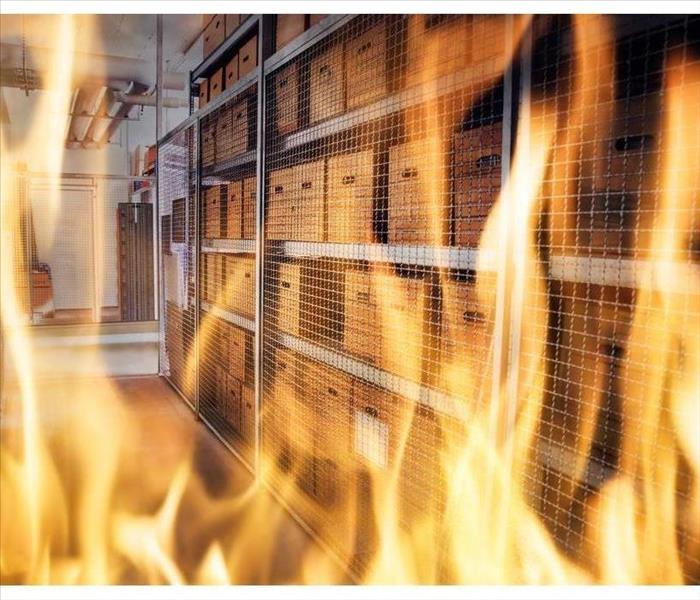 Fire in a warehouse in Two Lick, PA.
Fire in a warehouse in Two Lick, PA.
Prepare for a Commercial Fire
As a business owner in Two Lick, PA, you need to be prepared for the consequences of a commercial fire. You should be ready to deal with possible expenses due to the cost of fire restoration and time lost while your business is closed. Luckily, you can greatly minimize the loss of time and money by taking the following steps.
1. Talk to Your Insurance Company
Contact your fire insurance company right away to let them know what's happened. The sooner you can file a claim and get an adjuster out to look at the damage, the sooner they can release the funds you need to get your building repaired and restored.
2. Call a Professional Fire Mitigation Company
Next, you should seek out the services of a fire restoration company. These professionals can come out immediately to do any needed emergency repairs and make a thorough inspection. They will then begin the process of removing any excess water left behind by fire hoses, smoke cleaning, and repair and restoration of the building.
3. Assessing Damage and Removing Property
When you can enter the building again, take care to wear a breathing mask to protect yourself from lingering smoke. Make an inventory of equipment that's been damaged, such as computers, phones, important documents and any other items. The insurance company will need this information for any possible reimbursement. Try to salvage as much equipment as possible. Much of it may be usable after a careful professional cleaning.
5. Bring in an Arson Investigation Team
It's a good idea to hire a forensics team to determine if there was any foul play. If there was arson involved, your insurer needs this information. If a guilty party is found, they may want to file charges and recover their costs.
Hopefully, you won't ever have to deal with fire restoration in your place of business. But if so, you'll be ready to take quick action by using the information outlined above.
A Few Facts About Floodwater
1/12/2022 (Permalink)
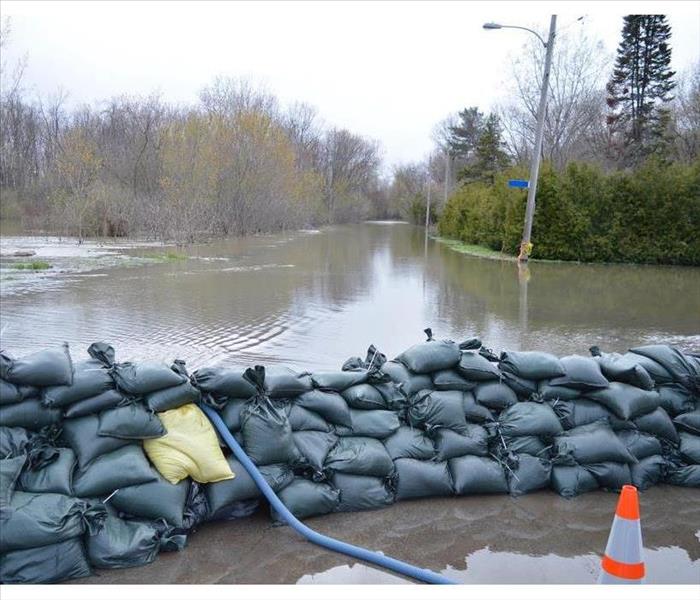 Water from a storm is considered Category 3 water.
Water from a storm is considered Category 3 water.
Things You Need To Know About Floodwater
Storm season in Black Lick, PA, can wreak havoc on your home. One of the most common problems that occur is water damage from floodwater. Homeowners often are tempted to clean up this type of mess themselves, but that is a mistake. Contact with the water should be avoided. To protect yourself and your family, there are some things you need to know about floodwater.
Contamination Category
Water from a storm is considered Category 3 water, which is highly contaminated. Removing it and repairing its damage requires professional help from water remediation specialists. Storm water can pick up contaminants from multiple sources:
- Backed up sewer system
- Agricultural or industrial runoff
- Toxic waste site overflow
- Oil or gasoline from driveways or streets
You never know where the water flooding your home has been. It's better to be on the safe side and avoid contact with it.
Contamination Levels
One of the first things that remediation experts are going to do when they come to your home is to determine the extent of the water damage. To do this, they discern the level of the Category 3 water. At Level 1, the water comes from an interior source. The amount of water is miniscule and hasn't soaked into anything yet. The damage caused at this level is relatively easy to fix. At Level 2, the water also comes from an interior overflow, but it affects a much larger area and may show signs of seeping into floors or walls. During a flood, however, the water comes from an outside source and causes quite a bit of damage. These factors make it Level 3 water. Not only must the water be removed, the area must also be disinfected before contractors can begin to make repairs.
Category 3 water damage necessitates drying, cleaning and repairing. If your home has been flooded by storm overflow, it is important to have the problem assessed and remedied by certified experts.
How Is Water Damage Classified?
1/4/2022 (Permalink)
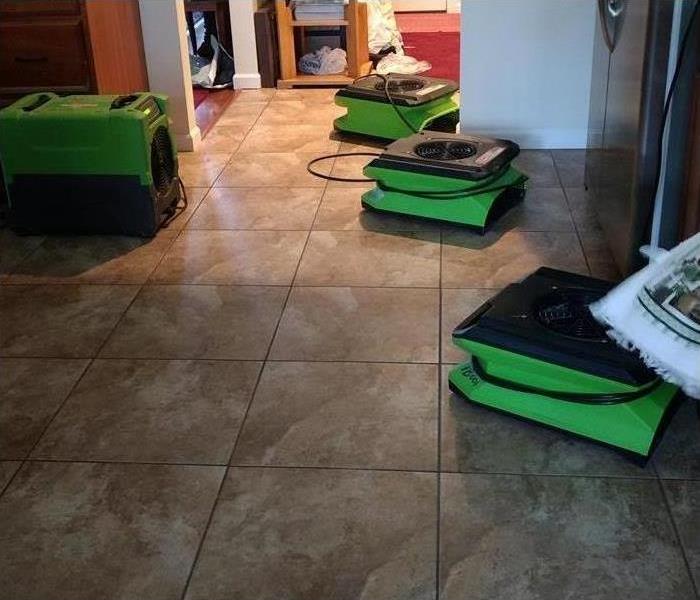 Air movers in a kitchen after a water loss.
Air movers in a kitchen after a water loss.
The Categories Of Water Damage
Restoration professionals classify water damage into three categories. The category corresponds to the degree of contamination. Category One water damage has the least contamination and requires the simplest cleanup process, even though damage from a pipe break can be extensive. Areas exposed to contaminated water must be disinfected. Learn more about the categories of water damage.
Category One
Category One water is not contaminated. This water originates from a supply line and has several distinctive qualities:
- Clean
- Treated
- May burst or spray
This category of water damage may involve large amounts of clean water. It is important to shut off the water supply and contact a plumber as soon as possible. Gather water and take immediate action to remove all standing water, as Category One water can degrade into contaminated water in as little as 48 hours.
Category Two
Category Two water is sometimes referred to as gray water. This category includes water from appliances, baths, or showers. This water may contain chemicals or microbes, but does not contain solid waste. It is still necessary to disinfect areas exposed to Category Two water.
Category Three
Category Three water is also known as black water. This water is highly contaminated and either contains solid waste or originates from outdoor flooding. There are a few common causes of incidents involving this category of water:
- Sewer backups
- Flooded toilets
- Heavy rain
- Rising bodies of water
It is a good idea to wear personal protective equipment while cleaning up Category Three water. It is also necessary to thoroughly disinfect any area exposed to this water.
These are the three categories of water damage used by experts. A homeowner may clean and dry minor leaks, but larger incidents or contaminated water may require the expertise of a residential cleanup and restoration firm in Homer City, PA. Professionals can properly treat primary damage and prevent additional damage.
 Finding your home's main water shutoff valve is an important step in protecting your property from water damage.
Finding your home's main water shutoff valve is an important step in protecting your property from water damage.





 24/7 Emergency Service
24/7 Emergency Service




























